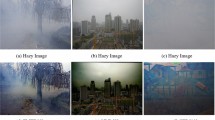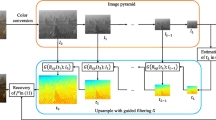Abstract
We propose a method for color dehazing with four main characteristics: it does not introduce color artifacts, it does not depend on inverting any physical equation, it is based on models of visual perception, and it is fast, potentially real time. Our method converts the original input image to the HSV color space and works in the saturation and value domains by: (1) reducing the value component via a global constrained histogram flattening; (2) modifying the saturation component in consistency with the previous reduced value; and (3) performing a local contrast enhancement in the value component. Results show that our method competes with the state-of-the-art when dealing with standard hazy images, and outperforms it when dealing with challenging haze cases. Furthermore, our method is able to dehaze a FullHD image on a GPU in 90 ms.









Similar content being viewed by others
References
Ancuti, C., Ancuti, C.: Single image dehazing by multi-scale fusion. IEEE Trans. Image Process. 22(8), 3271–3282 (2013)
Ancuti, C.O., Ancuti, C., Hermans, C., Bekaert, P.: A fast semi-inverse approach to detect and remove the haze from a single image. In: No. 6493 in Asian Conference on Computer Vision, ACCV-2010, pp. 501–514 (2010)
Ancuti, C., Ancuti, C.O., De Vleeschouwer, C.: D-hazy: A dataset to evaluate quantitatively dehazing algorithms. In: IEEE International Conference on Image Processing (ICIP), ICIP’16 (2016)
Bai, L., Wu, Y., Xie, J., Wen, P.: Real time image haze removal on multi-core dsp. Procedia Eng. 99, 244–252 (2015). https://doi.org/10.1016/j.proeng.2014.12.532. (2014 Asia-Pacific International Symposium on Aerospace Technology, APISAT2014 September 24–26, 2014 Shanghai, China)
Berman, D., Treibitz, T., Avidan, S.: Non-local image dehazing. In: IEEE Conference on Computer Vision and Pattern Recognition (CVPR) (2016)
Brainard, D.H.: The psychophysics toolbox. Sp. Vis. 10, 433–436 (1997)
Brenner, N., Bialek, W., de Ruyter van Steveninck, R.: Adaptive rescaling maximizes information transmission. Neuron 26(3), 695–702 (2000). https://doi.org/10.1016/S0896-6273(00)81205-2
Cai, B., Xu, X., Jia, K., Qing, C., Tao, D.: DehazeNet: an end-to-end system for single image haze removal (2016). arXiv:1601.07661
Carandini, M., Heeger, D.J.: Normalization as a canonical neural computation. Nat. Rev. Neurosci. 1, 51–62 (2011). https://doi.org/10.1038/nrn3136
Chen, C., Do, M.N., Wang, J.: Robust image and video dehazing with visual artifact suppression via gradient residual minimization. In: Computer vision—ECCV 2016—14th European Conference, pp. 576–591 (2016). https://doi.org/10.1007/978-3-319-46475-6_36
Choi, L.K., You, J., Bovik, A.C.: Referenceless prediction of perceptual fog density and perceptual image defogging. IEEE Trans. Image Process. 24(11), 3888–3901 (2015)
Cyriac, P., Kane, D., Bertalmío, M.: Perceptual dynamic range for in-camera image processing. In: British Machine Vision Conference (BMVC) (2015)
El-Hashash, M.M., Aly, H.A.: High-speed video haze removal algorithm for embedded systems. J. Real Time Image Process. (2016). https://doi.org/10.1007/s11554-016-0603-1
Fattal, R.: Single Image Dehazing. In: ACM SIGGRAPH 2008 Papers, SIGGRAPH ’08, pp. 72:1–72:9. ACM, New York, NY, USA (2008)
Fattal, R.: Dehazing using Color-Lines. In: ACM Transaction on Graphics. ACM, New York, NY, USA (2014)
Galdran, A., Vazquez-Corral, J., Pardo, D., Bertalmío, M.: Enhanced variational image dehazing. SIAM J. Imaging Sci. 8(3), 1519–1546 (2015)
Galdran, A., Vazquez-Corral, J., Pardo, D., Bertalmío, M.: Fusion-based Variational Image Dehazing. IEEE Signal Process. Lett. 24(2), 151–155 (2017)
Galdran, A., Alvarez-Gila, A., Bria, A., Vazquez-Corral, J., Bertalmío, M.: On the duality between Retinex and Image Dehazing. In: Computer Vision and Pattern Recognition (CVPR) (2018)
Gao, Y., Hu, H.M., Wang, S., Li, B.: A fast image dehazing algorithm based on negative correction. Signal Process. 103, 380–398 (2014)
Hautière, N., Tarel, J.P., Aubert, D., Dumont, E.: Blind contrast enhancement assesment by gradient rationing at visible edges. Image Anal. Stereol. 27(2), 87–95 (2011)
He, K., Sun, J., Tang, X.: Single image haze removal using dark channel prior. IEEE Trans. Pattern Anal. Mach. Intell. 33(12), 2341–2353 (2011)
Kastner, D.B., Baccus, S.A.: Insights from the retina into the diverse and general computations of adaptation, detection, and prediction. Curr. Opin. Neurobiol. 25, 6369 (2014). https://doi.org/10.1016/j.conb.2013.11.012.
Kopf, J., Neubert, B., Chen, B., Cohen, M., Cohen-Or, D., Deussen, O., Uyttendaele, M., Lischinski, D.: Deep photo: model-based photograph enhancement and viewing. In: ACM SIGGRAPH Asia 2008 Papers, pp. 116:1–116:10. ACM, New York, NY, USA (2008)
Koschmieder, H.: Theorie der horizontalen Sichtweite: Kontrast und Sichtweite. Keim & Nemnich, Frankfurt (1925)
Lai, Y.H., Chen, Y.L., Chiou, C.J., Hsu, C.T.: Single-image dehazing via optimal transmission map under scene priors. IEEE Trans. Circ. Syst. Video Technol. 25(1), 1–14 (2015)
Li, Y., Guo, F., Tan, R.T., Brown, M.S.: A contrast enhancement framework with jpeg artifacts suppression. In: ECCV 2014: 13th European Conference, pp. 174–188 (2014). https://doi.org/10.1007/978-3-319-10605-2_12
Li, Y., You, S., Brown, M.S., Tan, R.T.: Haze visibility enhancement: a survey and quantitative benchmarking. Comput. Vis. Image Underst. 165, 1–16 (2017). https://doi.org/10.1016/j.cviu.2017.09.003
Li, Z., Zheng, J.: Edge-preserving decomposition-based single image haze removal. IEEE Trans. Image Process. 24(12), 5432–5441 (2015)
Lissner, I., Preiss, J., Urban, P., Lichtenauer, M.S., Zolliker, P.: Image-difference prediction: from grayscale to color. IEEE Trans. Image Process. 22(2), 435–446 (2013). https://doi.org/10.1109/TIP.2012.2216279
Luan, Z., Shang, Y., Zhou, Z., Shao, Z., Guo, G., Liu, X.: Fast single image dehazing based on a regression model. Neurocomputing 245, 10–22 (2017)
Ma, K., Liu, W., Wang, Z.: Perceptual evaluation of single image dehazing algorithms. In: 2015 IEEE International Conference on Image Processing (ICIP), pp. 3600–3604 (2015). https://doi.org/10.1109/ICIP.2015.7351475
Matlin, E., Milanfar, P.: Removal of haze and noise from a single image. In: Proc. SPIE 8296, Computational Imaging X, vol. 8296, pp. 82,960T–82,960T–12 (2012). https://doi.org/10.1117/12.906773
Meng, G., Wang, Y., Duan, J., Xiang, S., Pan, C.: Efficient Image Dehazing with Boundary Constraint and Contextual Regularization. In: 2013 IEEE International Conference on Computer Vision (ICCV), pp. 617–624 (2013)
Mittal, A., Soundarajan, R., Bovik, A.C.: Making a completely blind image quality analyzer. IEEE Signal Process. Lett. 22(3), 209–212 (2013)
Mittal, A., Moorthy, A.K., Bovik, A.C.: No-reference image quality assessment in the spatial domain. IEEE Trans. Image Process. 21(12), 4695–4708 (2012)
Mizokami, Y., Takahashi, Y., Yaguchi, H.: Colorfulness perception of natural images adjusting to haze. In: The 23rd Symposium of the International Colour Vision Society (2015)
Mizokami, Y., Takahashi, Y., Yaguchi, H.: Stable colorfulness perception of scene through haze. In: Vision Sciences Society (VSS) (2016)
Narasimhan, S., Nayar, S.: Contrast restoration of weather degraded images. IEEE Trans. Pattern Anal. Mach. Intell. 25(6), 713–724 (2003)
Nishino, K., Kratz, L., Lombardi, S.: Bayesian defogging. Int. J. Comput. Vis. 98(3), 263–278 (2012)
Oakley, J., Bu, H.: Correction of simple contrast loss in color images. IEEE Trans. Image Process. 16(2), 511–522 (2007)
Olshausen, B.A., Field, D.J.: Vision and the coding of natural images. Am. Sci. 88(3), 238–245 (2000)
Pelli, D.G.: The videotoolbox software for visual psychophysics: transforming numbers into movies. Sp. Vis. 10(4), 437–442 (1997)
Pizer, S.M., Amburn, E.P., Austin, J.D., Cromartie, R., Geselowitz, A., Greer, T., Romeny, B.T.H., Zimmerman, J.B.: Adaptive histogram equalization and its variations. Comput. Vision Graph. Image Process. 39(3), 355–368 (1987). https://doi.org/10.1016/S0734-189X(87)80186-X
Schaul, L., Fredembach, C., Susstrunk, S.: Color image dehazing using the near-infrared. In: 2009 16th IEEE International Conference on Image Processing (ICIP), pp. 1629–1632 (2009)
Schechner, Y., Narasimhan, S., Nayar, S.: Instant dehazing of images using polarization. In: IEEE Computer Society Conference on Computer Vision and Pattern Recognition. CVPR 2001, vol. 1, pp. I–325–I–332 vol. 1 (2001)
Sun, W.: A new single-image fog removal algorithm based on physical model. Optik Int. J. Light Electron Opt. 124(21), 4770–4775 (2013)
Tan, R.: Visibility in bad weather from a single image. In: IEEE Conference on Computer Vision and Pattern Recognition, 2008. CVPR 2008, pp. 1–8 (2008)
Tang, K., Yang, J., Wang, J.: Investigating Haze-Relevant Features in a Learning Framework for Image Dehazing. In: 2014 IEEE Conference on Computer Vision and Pattern Recognition (CVPR), pp. 2995–3002 (2014)
Tang, K., Yang, J., Wang, J.: Investigating haze-relevant features in a learning framework for image dehazing. In: 2014 IEEE Conference on Computer Vision and Pattern Recognition, pp. 2995–3002 (2014). https://doi.org/10.1109/CVPR.2014.383
Tarel, J.P., Hautiere, N.: Fast visibility restoration from a single color or gray level image. In: 2009 IEEE 12th International Conference on Computer Vision, pp. 2201–2208 (2009)
Tarel, J.P., Hautiere, N., Caraffa, L., Cord, A., Halmaoui, H., Gruyer, D.: Vision enhancement in homogeneous and heterogeneous fog. IEEE Intell. Transp. Syst. Mag. 4(2), 6–20 (2012)
Tarel, J.P., Hautiere, N., Cord, A., Gruyer, D., Halmaoui, H.: Improved visibility of road scene images under heterogeneous fog. In: 2010 IEEE Intelligent Vehicles Symposium (IV), pp. 478–485 (2010)
Vazquez-Corral, J., Zamir, S., Galdran, A., Pardo, D., Bertalmío, M.: Image processing applications through a variational perceptually-based color correction related to retinex. In: IS&T Electronic Imaging Conference (2016)
Wan, Y., Chen, Q.: Joint image dehazing and contrast enhancement using the hsv color space. IEEE International Conference on Visual Communications and Image Processing (2015)
Wang, J.B., He, N., Zhang, L.L., Lu, K.: Single image dehazing with a physical model and dark channel prior. Neurocomputing 149(Part B), 718–728 (2015)
Wang, S., Cho, W., Jang, J., Abidi, M.A., Paik, J.: Contrast-dependent saturation adjustment for outdoor image enhancement. J. Opt. Soc. Am. A 34(1), 7–17 (2017). https://doi.org/10.1364/JOSAA.34.000007
Wang, W., Yuan, X.: Recent advances in image dehazing. IEEE/CAA J. Autom. Sin. 4(3), 410–436 (2017)
Wang, W., Yuan, X., Wu, X., Liu, Y.: Dehazing images with a large sky region. Neurocomputing 238, 365–376 (2017)
Wang, W., Yuan, X., Wu, X., Liu, Y.: Fast Image dehazing method based on linear transformation. IEEE Trans. Multimed. 19(6), 1142–1155 (2017)
Wang, Y., Wang, H., Yin, C., Dai, M.: Biologically inspired image enhancement based on Retinex. Neurocomputing 177, 373–384 (2016)
Yoon, I., Kim, S., Kim, D., Hayes, M.H., Paik, J.K.: Adaptive defogging with color correction in the hsv color space for consumer surveillance system. IEEE Trans. Consum. Electron. 58(1), 111–116 (2012)
Zhang, X.S., Gao, S.B., Li, C.Y., Li, Y.J.: A retina inspired model for enhancing visibility of hazy images. Front. Comput. Neurosci. 9, 151 (2015)
Zhu, Q., Mai, J., Shao, L.: A fast single image haze removal algorithm using color attenuation prior. IEEE Trans. Image Process. 24(11), 3522–3533 (2015)
Acknowledgements
This work has received funding from the European Union's Horizon 2020 research and innovation programme under grant agreement number 761544 (project HDR4EU) and under grant agreement number 780470 (project SAUCE), and by the Spanish government and FEDER Fund, grant ref. TIN2015-71537-P (MINECO/FEDER,UE). JVC was supported by the Spanish government, grant ref. IJCI-2014-19516. The NVIDIA Titan X used for this research was donated by the NVIDIA corporation.
Author information
Authors and Affiliations
Corresponding author
Appendix: sRGB/HSV color conversions
Appendix: sRGB/HSV color conversions
1.1 From sRGB to HSV
Given a pixel (R, G, B) in sRGB space, we start by defining \(M={\text {max}}(R,G,B)\) and \(m={\text {min}}(R,G,B)\). Let us also define an auxiliary variable \(H'\) in the following way
Then, the HSV coordinates are defined as
1.2 From HSV to sRGB
Given a pixel (H, S, V) in the HSV space we start by defining \(C=S\times V\), \(H'=\frac{H}{60}\), \(X=C\times (1- \Vert H' \mod 2 -1\Vert )\), and \(m=V-C\). Then the pixel value in sRGB color space is defined as
Rights and permissions
About this article
Cite this article
Vazquez-Corral, J., Galdran, A., Cyriac, P. et al. A fast image dehazing method that does not introduce color artifacts. J Real-Time Image Proc 17, 607–622 (2020). https://doi.org/10.1007/s11554-018-0816-6
Received:
Accepted:
Published:
Issue Date:
DOI: https://doi.org/10.1007/s11554-018-0816-6




